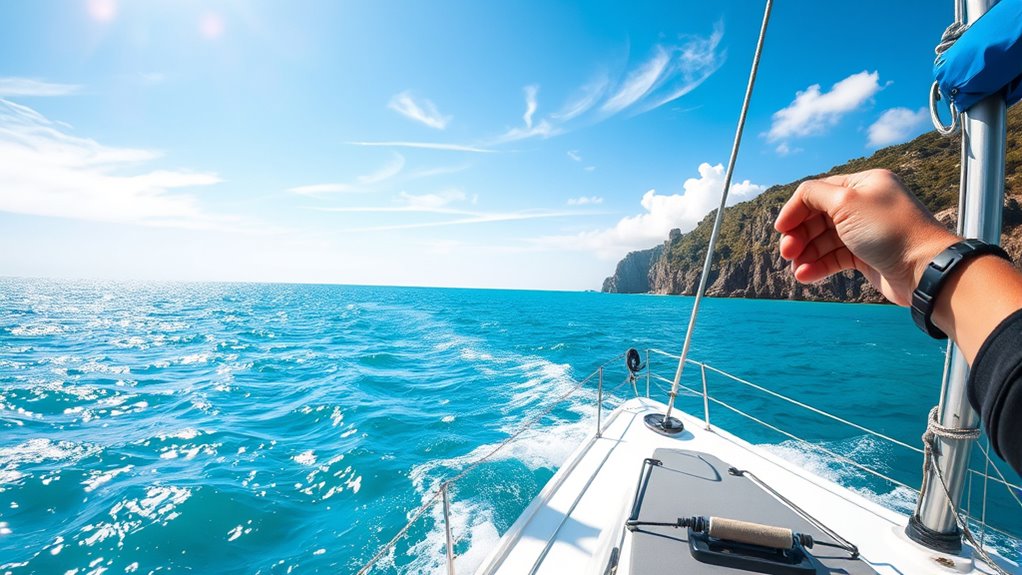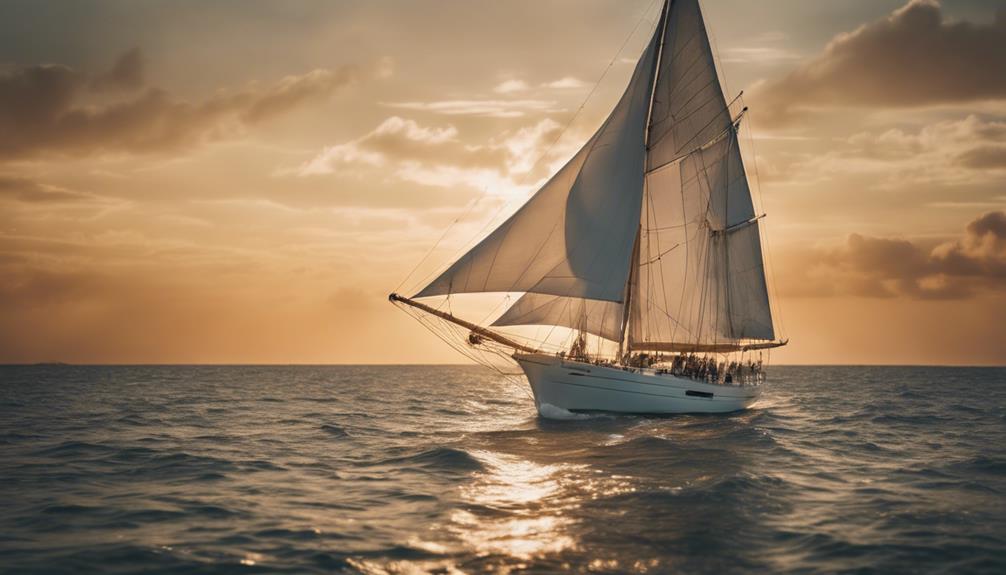To plan a sailing adventure, start by choosing a boat suited to your skills, trip length, and conditions. Research destinations, routes, and weather patterns, then organize necessary permits and documentation. Assemble your crew, assign roles, and prepare safety equipment, emergency plans, and navigation tools. Pack essentials carefully, keeping organized and lightweight. Check weather forecasts regularly and be flexible with your itinerary. If you want to make certain of a smooth voyage, there’s more to consider beyond these basics.
Key Takeaways
- Match your vessel to your skill level, trip length, and sea conditions, ensuring safety and comfort.
- Research destinations, plan routes, and create a flexible itinerary considering weather and hazards.
- Verify legal requirements, permits, visas, and ensure all documentation and insurance are up to date.
- Monitor weather forecasts, prepare navigation tools, and assign crew roles for safe voyage execution.
- Pack appropriate safety gear, emergency supplies, and organize safety procedures and drills before departure.
Selecting the Ideal Boat for Your Journey
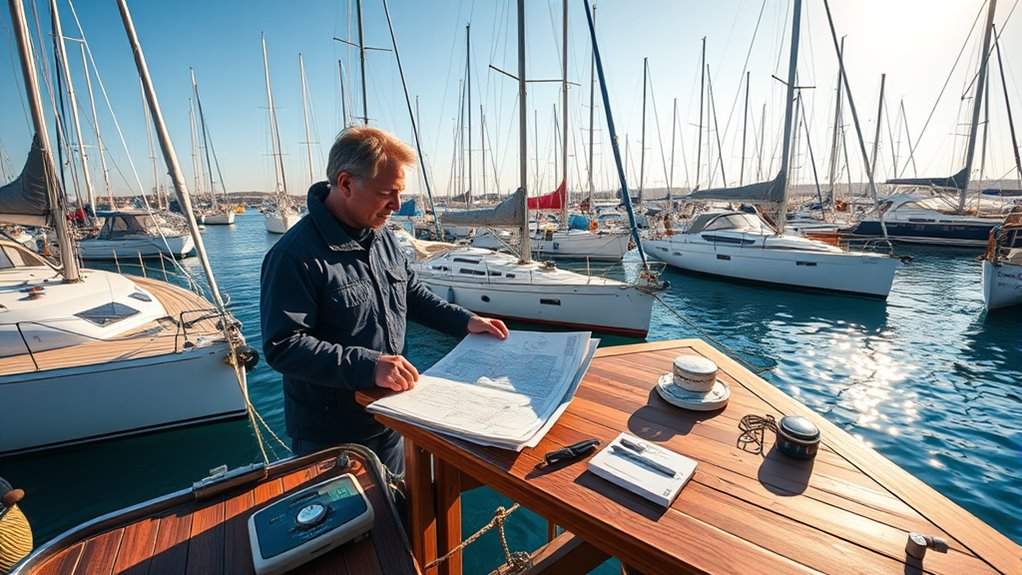
Choosing the right boat is essential to ensuring a smooth and enjoyable sailing adventure. You need a vessel that matches your skill level, trip length, and planned conditions. If you’re a beginner, contemplate a smaller, stable sailboat or a cruiser with easy handling features. For longer trips or open water, opt for a boat with ample storage, comfortable living spaces, and reliable equipment. Think about the boat’s type—mono-hull or catamaran—based on your comfort and stability needs. Check the boat’s condition, ensuring it’s well-maintained and seaworthy. You’ll also want to consider onboard amenities and safety features, like navigation systems and life-saving gear. Incorporating the concept of boat stability into your decision can significantly impact your comfort and safety on the water. Additionally, evaluating the boat’s suitability for different sea conditions can help prevent unexpected issues during your voyage. Understanding prophetic dreams and their symbolism can also offer insights into the subconscious signals that might influence your decision-making process. Considering celebrity lifestyle insights can sometimes provide inspiration for how to personalize your space onboard or enhance your overall experience. Remember to assess the resilience of the boat’s structure to ensure it can withstand the environmental challenges you may encounter.
Determining the Perfect Destination and Route

Once you’ve selected the right boat, the next step is deciding where to steer your adventure. Start by considering your interests, whether you’re after relaxing beaches, vibrant ports, or secluded coves. Research destinations that match your desired experience, paying attention to climate, seasonal weather, and local events. Map out potential routes, balancing scenic spots with safety and navigational ease. Consult nautical charts and guides to identify hazards and favored anchorages. Think about travel distances between stops to ensure manageable legs each day. Remember, flexibility is key—weather can change, and new opportunities may arise. Be aware of cruise cancellation policies that could impact your plans. Additionally, exploring local attractions such as Water Parks can add extra fun to your trip. By carefully choosing your destination and route, you set the foundation for an enjoyable, memorable sailing adventure tailored just for you.
Checking and Preparing Necessary Permits and Documentation
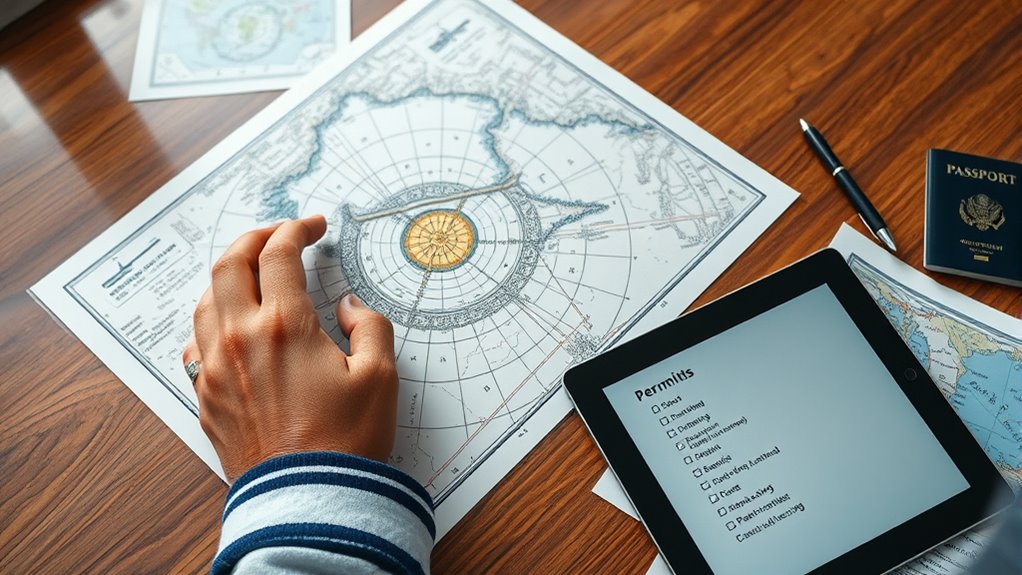
Before you set sail, make sure you confirm the entry requirements for each port you’ll visit. Obtain all necessary permits early to avoid delays or fines. Additionally, prepare your legal documentation, like passports and boat registration papers, to ensure smooth boarding and compliance. Being aware of regulatory compliance challenges and how your data might be used during the planning process can also help you better understand the services and platforms you rely on. It’s also important to review the website’s privacy and cookie policies to understand how your information is collected and managed during your preparations.
Verify Entry Requirements
Have you checked the entry requirements for the countries you’ll be visiting? It’s essential to understand each destination’s visa policies, vaccination rules, and customs regulations. Some countries may require specific visas or electronic travel authorizations, so verify these well in advance. Make sure your passport is valid for at least six months beyond your intended stay. Check if you need special permits for anchoring or mooring in certain areas. Contact embassies or official government websites to get the latest info. Failing to meet entry requirements can delay or even prevent your trip, so don’t overlook this step. Gathering accurate, up-to-date documentation ensures a smooth entry process and helps you avoid unnecessary complications during your sailing adventure. Additionally, understanding the importance of attention in creative practice can remind you to stay focused when organizing your travel documents.
Obtain Necessary Permits
To guarantee your sailing trip goes smoothly, you need to check and prepare all necessary permits and documentation well in advance. Start by researching the regulations for each country and port you’ll visit. Some locations require specific cruising permits, transit visas, or maritime clearances. Contact relevant authorities or consult your local maritime agency to confirm what’s needed. Ensure your boat registration, insurance papers, and crew identification are up-to-date and easily accessible. Missing permits can cause delays, fines, or denied entry, so double-check all requirements early. Keep digital and hard copies of all permits, visas, and documentation organized in a dedicated folder. Being prepared reduces stress and keeps your journey on track from the moment you set sail.
Prepare Legal Documentation
Ensuring your legal documentation is complete and accurate is essential for a smooth sailing experience. Before setting sail, double-check that you have all required permits, visas, and registration papers for each jurisdiction you’ll visit. Make sure your boat’s registration and insurance are up to date and valid for international waters. Keep digital and printed copies of all documents in a safe, accessible place onboard. Verify any specific documentation needed for visiting foreign ports or protected areas. If you’re uncertain, consult local authorities or a maritime legal expert. Properly prepared paperwork prevents delays, fines, or legal issues that could disrupt your journey. Additionally, reviewing Glycolic Acid Benefits for Skin can be useful for maintaining your skin health during long voyages. Being aware of automated systems and their operation can also help in case of technical issues when navigating unfamiliar waters.
Planning for Safety and Emergency Procedures

Preparing for safety and emergency procedures is a crucial step that can make or break your sailing adventure. You need to familiarize yourself with essential safety equipment, like life jackets, flares, and fire extinguishers, ensuring everything is in working order. Make sure you and your crew know how to respond to common emergencies, such as man overboard situations or fires. Create clear communication protocols, including how to contact rescue services and use radio equipment. Practice safety drills before setting sail, so everyone knows their role. Keep emergency contact information and medical supplies accessible. Additionally, understanding the importance of project management support can help coordinate safety efforts effectively. Being aware of local store hours can also be beneficial if you need to make last-minute supplies or adjustments during your trip. By planning thoroughly, you’ll boost your confidence and safety, reducing risks and ensuring you’re prepared for unexpected situations that might arise during your journey.
Creating a Detailed Itinerary and Schedule
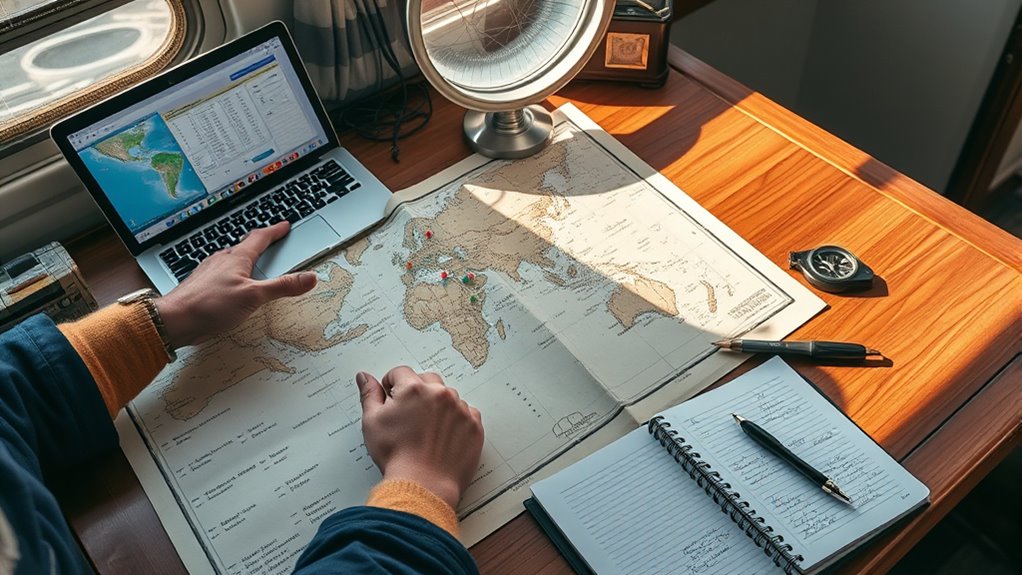
Creating a detailed itinerary and schedule is essential for keeping your sailing trip organized and on track. It helps you allocate time efficiently and guarantees you hit your must-see spots. To craft an effective plan: 1. Identify key destinations and anchor points** to visit each day. 2. Estimate travel times between locations, accounting for weather and sea conditions. 3. Schedule daily activities, including sightseeing, relaxation, and meals. 4. Build in buffer time** for unexpected delays or weather changes. Incorporating safety considerations ensures your plan remains practical and adaptable throughout your journey. Additionally, understanding zodiac sign compatibility can help in planning social activities or shared experiences onboard, fostering better harmony among crew members. Recognizing the influence of family dynamics may also be beneficial when coordinating group activities or managing interpersonal relationships during your trip. Moreover, reviewing local regulations helps ensure compliance and avoid potential issues during your adventure. Being aware of weather patterns can assist in adjusting your schedule proactively to ensure safety and comfort.
Packing Smart: Essentials and Personal Items
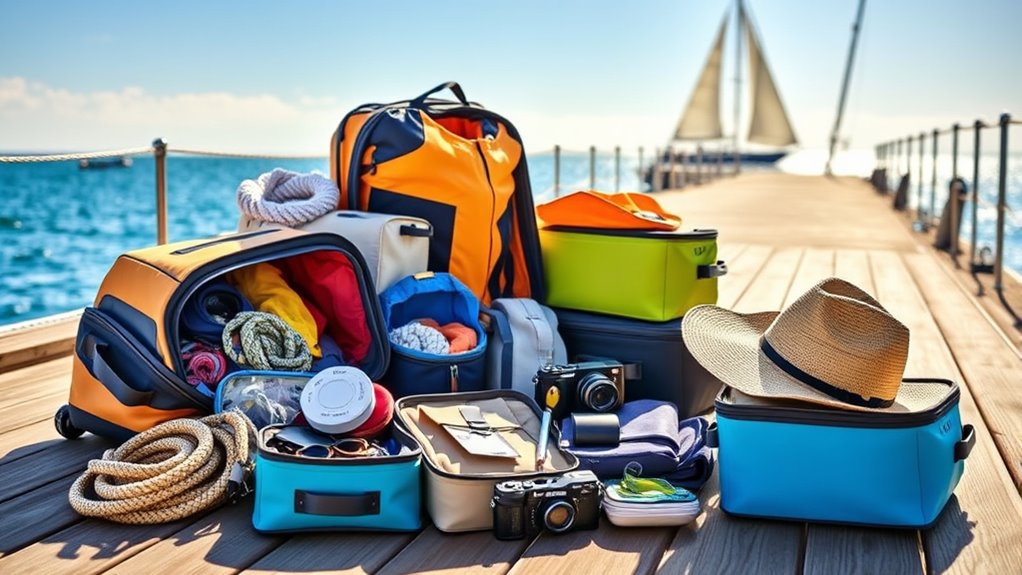
When packing for your sailing trip, choose versatile clothing that keeps you comfortable and shielded from the elements. Don’t forget essential hygiene supplies to stay fresh, and pack safety gear like life jackets and a first aid kit to handle emergencies. Being prepared with these essentials ensures you can enjoy your adventure confidently and safely. Consider including some Bitcoin IRA tax strategies such as tax-loss harvesting or long-term capital gains considerations to optimize your financial planning during your trip and beyond.
Essential Clothing Choices
Packing the right clothing is essential for a comfortable sailing adventure, especially since you’ll be exposed to sun, wind, and water throughout your trip. You need gear that protects you and keeps you comfortable.
Here are four must-have clothing items:
- Lightweight, quick-drying shirts to stay cool and dry.
- A wide-brim hat or cap to shield you from the sun.
- Waterproof jacket or windbreaker for sudden weather changes.
- Swimsuits and multiple pairs of shorts for water activities and comfort.
Choose breathable fabrics and layer your clothing to adapt to changing conditions. Avoid heavy or cotton clothes that hold moisture. Proper clothing ensures you stay protected, comfortable, and ready to enjoy every moment on the water.
Personal Hygiene Supplies
After choosing the right clothing to stay comfortable and protected, it’s important to contemplate your personal hygiene supplies. Pack travel-sized essentials like biodegradable soap, a toothbrush, toothpaste, and a small towel. Consider bringing moist wipes for quick cleanups and hand sanitizer to maintain hygiene on the go. A compact hairbrush or comb can help keep your hair manageable, while deodorant ensures freshness throughout the day. If you wear contact lenses, carry solution and a case, or opt for glasses to avoid hassle. Don’t forget feminine hygiene products if needed, and pack a small, sealed bag to keep everything organized. Keep your supplies lightweight and moisture-resistant to prevent spills and ensure easy access during your sailing adventure.
Safety and Emergency Gear
Ensuring you have the right safety and emergency gear is crucial for a smooth sailing adventure. Being prepared can make all the difference in unexpected situations. Here are four essential items you should pack:
- Life Jackets – Ensure each person has a well-fitting, Coast Guard-approved life jacket.
- Emergency Flares and Signaling Devices – Carry waterproof flares, a whistle, and a mirror to signal for help.
- First Aid Kit – Include bandages, antiseptics, pain relievers, and any personal medications.
- VHF Radio or Emergency Beacon – Keep a reliable communication device to contact rescue services if needed.
Having these items ready ensures you’re prepared for emergencies, giving you peace of mind and increasing safety on your sailing adventure.
Understanding Weather Patterns and Navigational Challenges

Understanding weather patterns and navigational challenges is essential for a safe and successful sailing adventure. You need to monitor forecasts regularly, noting wind speeds, directions, and potential storms. Familiarize yourself with local weather signs and seasonal trends to anticipate sudden changes. Pay attention to tide charts and currents, which can affect your route and fuel efficiency. Navigational challenges like shallow waters, reefs, and busy shipping lanes demand careful planning and constant awareness. Use reliable charts, GPS, and other navigation tools to stay on course. Always have a contingency plan if weather shifts unexpectedly. Staying vigilant about weather and navigation helps you avoid hazards, conserve energy, and ensure a smoother, more enjoyable journey on the water.
Assembling Your Crew and Assigning Roles
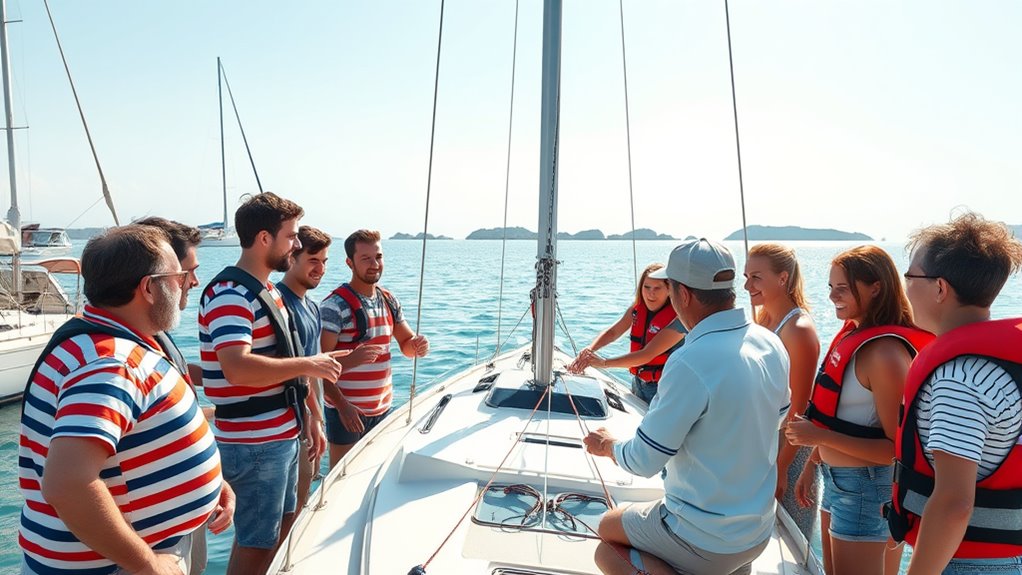
Assembling a capable crew is essential for a safe and efficient sailing adventure, and assigning clear roles guarantees everyone knows their responsibilities. A well-organized crew minimizes confusion and enhances safety. Consider these key roles:
- Skipper – The leader, responsible for navigation and decision-making.
- Helmsman – Handles steering and maintains course.
- Deckhand – Manages sails, lines, and general deck duties.
- Lookout – Watches for obstacles, other vessels, and weather changes.
Choose crew members with relevant skills or willingness to learn. Clearly define each role before setting sail, and ensure everyone understands their duties. Effective communication and role clarity boost confidence and safety, making your adventure smoother and more enjoyable.
Final Preparations and Pre-Sailing Checks
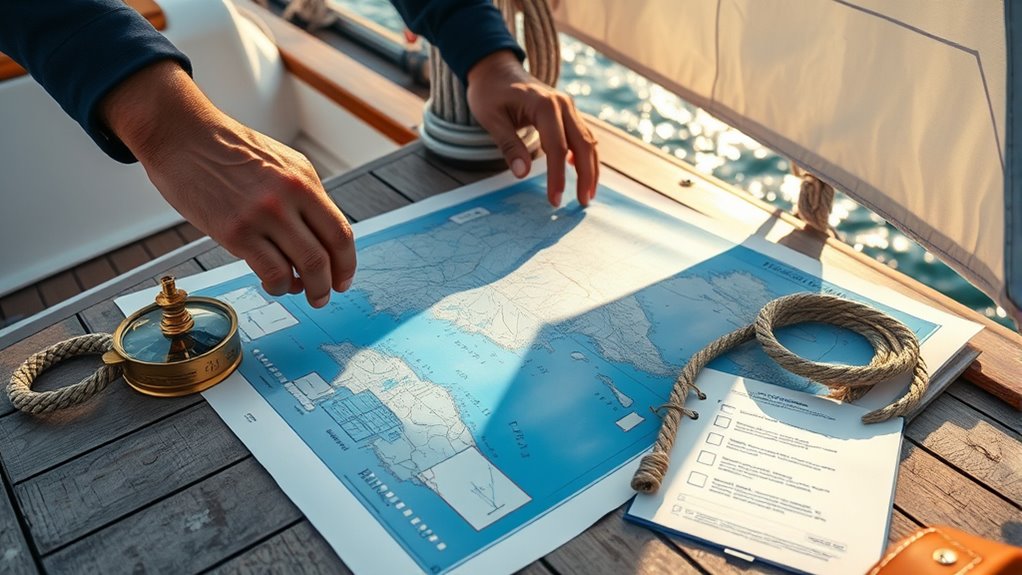
Before setting out, you need to complete final preparations and thorough pre-sailing checks to guarantee everything is in order. Start by inspecting the boat’s hull, rigging, and sails for any damage or wear. Check the engine, fuel levels, and oil to ensure reliable operation. Test all safety equipment, including life jackets, fire extinguishers, and flares, making sure they’re accessible and up to date. Review navigation tools like charts, GPS, and radios, confirming they’re functioning properly. Verify that all essential supplies—food, water, and first aid kits—are onboard and stored securely. Double-check weather forecasts to avoid surprises. By completing these steps, you minimize risks and set yourself up for a smooth, enjoyable sailing adventure.
Frequently Asked Questions
How Do I Choose the Right Sailing Season for My Trip?
Choosing the right sailing season depends on your destination and what you want from your trip. You should research local weather patterns, avoiding hurricane or storm seasons. Consider the peak tourist times, which might mean crowded spots and higher prices. Check wind conditions and water temperatures to make certain of comfortable sailing. Ultimately, pick a season that offers reliable weather, good wind, and enjoyable conditions for your adventure.
What Are Common Challenges Faced by First-Time Sailors?
When you’re new to sailing, you might face challenges like managing boat handling, understanding navigation, and handling unexpected weather. You could feel overwhelmed by the technical aspects or worried about safety. It’s common to experience stress adjusting to the wind and currents. To overcome these, take sailing courses, practice regularly, and always check weather forecasts. Confidence builds with experience, so stay patient and keep learning as you go.
How Can I Budget Effectively for a Sailing Adventure?
Budgeting for a sailing adventure begins with balancing your basics and bravado. Break down your costs—boat rental, gear, groceries, and group fees—and track them thoroughly. Consider contingencies for costly complications and cut unnecessary costs. Create a clear, consistent cash flow plan, and prioritize spending on essentials. With wise planning and careful calculation, you’ll conquer costs comfortably, ensuring your sailing journey stays joyful and just within your financial footing.
What Skills Are Essential for Handling Unexpected Situations?
When handling unexpected situations on your sailing trip, you need essential skills like quick decision-making, problem-solving, and adaptability. Stay calm under pressure and assess the situation thoroughly. Basic navigation and first aid knowledge are vital, as is understanding your boat’s systems. Communication skills help you coordinate with crew or rescue services. Practice these skills beforehand to build confidence, so you’re prepared when surprises arise.
How Do I Find Reliable Local Support or Marinas?
Finding reliable local support or marinas is like searching for a lighthouse in the fog. You should research online reviews, ask fellow sailors for recommendations, and contact local sailing clubs. Once you identify options, visit the marinas personally if possible, to gauge their facilities and staff professionalism. Building relationships with trusted contacts guarantees you have dependable support, making your sailing journey smoother and more enjoyable.
Conclusion
With careful planning, your sailing adventure can be unforgettable. Imagine setting sail with your friends, confident in your route, safety measures, and packed essentials—all based on your thorough preparation. Like Sarah, who navigated her first solo trip successfully because she researched weather patterns and assembled a reliable crew beforehand. So, trust your planning, stay flexible, and enjoy the thrill of the open sea. Your perfect sailing journey is just a well-prepared step away.

